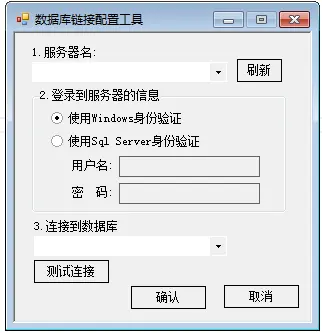
using System;
using System.Collections.Generic;
using System.ComponentModel;
using System.Data;
using System.Drawing;
using System.Linq;
using System.Text;
using System.Threading.Tasks;
using System.Windows.Forms;
using StudentManager.com.huixin.util;
using System.Collections;
using System.Data.ProviderBase;
using SQLDMO;
using System.Data.SqlClient;
namespace StudentManager
{
public partial class DataSourceConfig : Form
{
//连接数据库的类型
private String sqlConType = "";
public DataSourceConfig()
{
InitializeComponent();
}
//配置数据库链接的窗体关闭时,打开相对应登录窗体
private void DataSourceConfig_FormClosed(object sender, FormClosedEventArgs e)
{
try
{
//杀死进程
//System.Diagnostics.Process.GetCurrentProcess().Kill();
//关闭当前窗体
//终止当前进程并为基础操作系统提供指定的退出代码
//System.Environment.Exit(System.Environment.ExitCode);
this.Dispose();
this.Close();
//打开登录窗体
LoginForm lf = new LoginForm();
lf.Show();
//
LoginForm.loginFrm.Show();
}
catch (Exception ex)
{
Console.WriteLine("连接数据的窗体进程出错了:" + ex.Message);
}
}
//显示组合框的下拉部分时发生
private void comboBox1_DropDown(object sender, EventArgs e)
{
this.comboBox1.DataSource = SqlLocator.GetLocalSqlServerNamesWithSqlClientFactory();
this.comboBox1.DisplayMember = "ServerName";
}
//当用户点击刷新按钮时,将局域网内服务器和实例名给comobox
private void button1_Click(object sender, EventArgs e)
{
this.comboBox1.DataSource = SqlLocator.GetLocalSqlServerNamesWithSqlClientFactory();
this.comboBox1.DisplayMember = "ServerName";
}
//在窗体加载时,将Sql Server按钮以及和他相关两个文本框禁用
private void DataSourceConfig_Load(object sender, EventArgs e)
{
//Windows的按钮默认被选中
this.radioButton1.Select();
this.textBox1.Enabled = false;
this.textBox2.Enabled = false;
}
private void radioButton1_Click(object sender, EventArgs e)
{
if (this.radioButton1.Checked == true) {
sqlConType = "0";
}
}
private void radioButton2_CheckedChanged(object sender, EventArgs e)
{
if (this.radioButton2.Checked == true)
{
sqlConType = "1";
this.textBox1.Enabled = true;
this.textBox2.Enabled = true;
}
}
//3.点击数据库链接时显示时,组合框的下拉部分时发生
private void comboBox2_DropDown(object sender, EventArgs e)
{
//通过第一步输入的服务器实例名,从而找到步骤三中的数据库
//通过判断用户点击的属于哪一种数据库连接方式,从而判断采用什么方法
if (sqlConType == "0") { //用户选择的是Windows方式
this.comboBox2.DataSource = GetDataBaseList(this.comboBox1.SelectedItem.ToString());
this.comboBox2.DisplayMember = "";
}
else if (sqlConType == "1") { //用户选择了Sql Server方式
this.comboBox2.DataSource = GetDataBaseList(this.comboBox1.SelectedItem.ToString(),this.textBox1.Text.Trim().ToString(),this.textBox2.Text.Trim().ToString());
this.comboBox2.DisplayMember = "";
}
}
//得到指定SQL服务器所有数据库的列表
//这种输入Sql Server模式,需要用户名和密码
public ArrayList GetDataBaseList(string ServerName, string UserName, string Pwd)
{
//一般使用SQLDMO,只能用于sql server2005一般的版本
ArrayList list = new ArrayList();
SqlConnection conn = new SqlConnection("Uid=" + UserName + ";Pwd=" + Pwd + ";Data Source=SQL2012;Integrated Security=false;"); ;
SqlCommand cmd = new SqlCommand("select name from sys.databases where database_id > 4", conn); ;
try
{
if (conn.State == ConnectionState.Closed){
conn.Open();
SqlDataReader dr = cmd.ExecuteReader();
while (dr.Read())
{
list.Add(dr[0]);
}
}
}
catch (Exception ex)
{
MessageBox.Show(ex.Message);
}
finally
{
if (conn != null && conn.State == ConnectionState.Open)
{
conn.Close();
conn.Dispose(); //释放资源
}
}
/**
SQLDMO.Application sqlApp = new SQLDMO.Application();
SQLDMO.SQLServer oServer = new SQLDMO.SQLServer("Data Source="+ServerName+";Persist Security Info=True;UID="+UserName+";PWD="+Pwd+"");
oServer.Connect(ServerName,UserName,Pwd);
foreach (SQLDMO.Database db in oServer.Databases)
{
if ((db.Name != null) && (db.SystemObject == false))
{
list.Add(db.Name);
}
}
**/
return list;
}
//这种属于Windows方式
//此时链接数据库时,需要加integrated security=SSPI
public ArrayList GetDataBaseList(string ServerName)
{
//一般使用SQLDMO,只能用于sql server2005一般的版本
ArrayList list = new ArrayList();
SqlConnection conn = new SqlConnection("Data Source=" + ServerName + ";Integrated Security=SSPI;Initial Catalog=mwyqms_2016-03-25");
SqlCommand cmd = new SqlCommand("select name from sys.databases where database_id > 4", conn); ;
try
{
if (conn.State == ConnectionState.Closed)
{
conn.Open();
SqlDataReader dr = cmd.ExecuteReader();
while (dr.Read())
{
list.Add(dr[0]);
}
}
}
catch (Exception ex)
{
MessageBox.Show(ex.Message);
}
finally
{
if (conn != null && conn.State == ConnectionState.Open)
{
conn.Close();
conn.Dispose(); //释放资源
}
}
return list;
}
}
}

第1步可以获取所有区域网内的服务器名,但是第三步骤无法从特定的服务器名下,通过用户名和密码,得到数据库
代码:
版权声明:本文内容由阿里云实名注册用户自发贡献,版权归原作者所有,阿里云开发者社区不拥有其著作权,亦不承担相应法律责任。具体规则请查看《阿里云开发者社区用户服务协议》和《阿里云开发者社区知识产权保护指引》。如果您发现本社区中有涉嫌抄袭的内容,填写侵权投诉表单进行举报,一经查实,本社区将立刻删除涉嫌侵权内容。